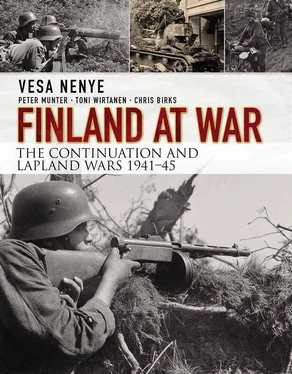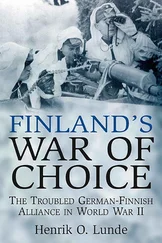A Finnish military delegation led by General Heinrichs travels to Germany and is told about the plans for Operation Barbarossa .
31 May
Finland asks Germany to guarantee its independence, the import of foodstuffs and the restoration of its 1939 borders.
3 June
Germany pledges to support Finland should it find itself embroiled in another war with the Soviets. Finnish-German military negotiations begin in Helsinki.
5 June
Mannerheim recalls Talvela to active duty.
6 June
The first 120 secretly recruited volunteers depart Finland for the Waffen-SS. At the end of June, recruitment for the 1,500-strong Finnish battalion of the SS-Division ‘Wiking’ begins officially.
7 June
The first German formations move to Finland from bases in Norway.
15 June
Hjalmar Siilasvuo’s III Army Corps is mobilised under German command in northern Finland.
17 June
Finland declares general mobilisation in a context of extraordinary military manoeuvres.
21 June
The Finns are informed that Operation Barbarossa will begin the following day.
22 June
Operation Barbarossa begins. Unprovoked, the Soviets bomb Finnish fortifications and vessels around Hanko and Åland. Luftwaffe bombers attacking the USSR are allowed to use Finnish airfields on their return legs (taking off from Finnish soil is not sanctioned until 25 June). Mannerheim orders the garrisoning of the Åland Islands. The Finnish Navy is allowed to participate in laying mines in the Gulf of Finland, in cooperation with the Germans.
23 June
Hitler’s speech about brothers-in-arms in Finland causes a political scandal. Molotov demands an explanation from the Finnish government regarding its position towards Germany. The Soviet Union evacuates its embassy in Helsinki.
24 June
The Wehrmacht issues orders to Finnish troops under its command in the north of Finland not to cross national borders.
25 June
The Soviet Union bombs civilian and industrial targets in Finnish territory. Soviet artillery also fires on Finnish troop positions. The Finnish Air Force and anti-aircraft forces destroy 27 enemy planes. Prime Minister Rangell informs the Finnish parliament that Finnish neutrality has been violated and that Finland finds itself in a state of war. The Continuation War begins.
28 June
The Finnish military is given permission to cross the national border for reconnaissance and to occupy empty sectors of no man’s land.
29 June
Operation Platinfuchs ( Platinum Fox ) begins. German forces attack Soviet positions from Lapland and Norway.
30 June
Major-General Talvela is given the critical command of VI Army Corps.
1 July
The German attack towards Murmansk (Operation Platinfuchs ) grinds to a halt at the Soviet line at Litsajoki. Operation Polarfuchs ( Arctic Fox ) sees an attack launched towards Salla. The Finnish 6th Division (attached to the Wehrmacht) begins its own attack as part of the overall plan. Siilasvuo’s III Army Corps, under the command of Army Command Norway (AOK Norwegen), begins its attack.
3 July
Siilasvuo’s troops capture the village of Vuokkiniemi.
4 July
The 14th Division, led by Colonel Raappana, is ordered over the Soviet border. These are the first troops under Finnish command to invade the USSR since the Kinship Wars.
7 July
The village of Vuonninen is captured by Siilasvuo’s III Army Corps. Task Force J proceeds forward to Kiestinki. Salla is captured as planned in Operation Polarfuchs with the help of the Finnish 6th Division.
8 July
Group O begins its advance; its troops are eventually halted by the strength of the enemy at Ristisalmi. Raappana’s 14th Division captures the village of Repola and continues towards Omelia.
10 July
The Karelian Army begins its offensive with both the VI and VII Army Corps. Mannerheim makes the so-called Sword Scabbard Declaration.
11 July
Heiskanen’s 11th Division liberates the town of Värtsilä. Task Force J reaches the Soviet defences at the Sohjana narrows, where the 242nd Rifle Regiment keeps it at bay.
12 July
Great Britain and the Soviet Union sign the Anglo-Soviet Agreement. Finnish troops under the command of Colonel Ruben Lagus reach Lake Tolvajärvi. The Finnish 14th Infantry Regiment is sent from Åland to reinforce Operation Platinfuchs .
14 July
Lieutenant-Colonel Väinö Merikallio leads the capture of Loimola village.
15 July
Colonel Antero Svensson’s 7th Division reaches the Soviet positions along the Matkaselkä railway. The 1st Jäger Brigade reaches Koirinoja on Lake Ladoga.
17 July
The 1st Jäger Brigade destroys a strong enemy column marching to reinforce Loimola village. Troops from Woldemar Hägglund’s VII Army Corps meet with those of the 11th Division at the Jänisjoki River.
18–22 July
Task Force Järvinen (VI Army Corps) secures the Lake Tulemajärvi area and then marches south, capturing the village of Suurmäki.
19 July
Mannerheim orders the Karelian Army to halt its attack on the Vitele–Vieljärvi line until further notice. Lagus’ forces capture Salmi after two days of fierce fighting.
22 July
Colonel Lagus and Major-General Talvela are made Knights of the Mannerheim Cross (Talvela’s cross is officially awarded 3 August). Lieutenant-Colonel Järvinen’s troops capture the village of Suurmäki.
23 July
Talvela’s VI Army Corps cross the former national border. The Stavka Glavnogo Komandovaniya – the Central Command of the Armed Forces of the USSR – is formed.
24 July
Talvela’s VI Army Corps captures the village of Vitele and proceeds to take positions along the Tuulosjoki River, halting their attack without crossing, as dictated by Mannerheim. In the north, the 14th Division captures the town of Omelia. Soviet troops are forced to retreat from the Ruskeala area.
29 July
The German 163rd Division push for Suojärvi is unsuccessful.
30 July
The Royal Air Force bombs Liinahamari harbour in Petsamo. British diplomats call this either a ‘tragic accident’ or ‘justified action against Germans, where Finland happened to be in the way’. It remains the only act of war between the two nations during the conflict.
31 July
Task Force J is reinforced by the Germans, and continues across the Sohjana River.
1 August
The Soviet counter-offensive in the Sortavala area fails, and the 168th and 198th Rifle divisions are forced to retreat. Mannerheim orders II Army Corps to begin its attack.
3 August
The battle for Kirvu; the extraordinary actions of Anti-Tank Gunner Vilho Rättö earn him the Mannerheim Cross.
5 August
The strategically important point village of Ilmee in Karelia is cleared by 18th Division.
7 August
Colonel Aarne Blick’s 2nd Division from II Army Corps, reaches Lahdenpohja. Large Soviet formations are now left in the Sortavala area between the II and VII Army Corps. By 14 August they have been destroyed.
8 August
Читать дальше












